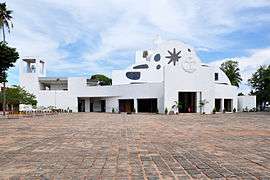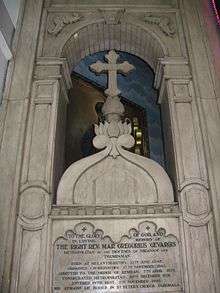St. Peter and St. Paul's Church, Parumala
| Parumala Church | |
|---|---|
 St. Peter's and St. Paul's Orthodox Syrian Church, Parumala | |
 Parumala Church | |
| 9°19′29″N 76°32′13″E / 9.3247°N 76.5369°ECoordinates: 9°19′29″N 76°32′13″E / 9.3247°N 76.5369°E | |
| Country | India |
| Denomination | Malankara Orthodox Syrian Church |
| Website | http://parumlachurch.org |
| History | |
| Founded | 1895 |
| Architecture | |
| Architect(s) | Charles Correa |
| Construction cost | INR 4 crore (40 million) [1] |
| Specifications | |
| Capacity | 2000 worshippers |
| Administration | |
| Diocese | Niranam Diocese |
| Clergy | |
| Bishop(s) | Dr. Yuhanon Mar Chrisostomos |
| Vicar(s) | Fr. M C Kuriakose |
St. Peter's and St. Paul's Orthodox Syrian Church, Parumala, also known as Parumala Pally, is a parish church of the Malankara Orthodox Syrian Church.
History
Parumala is a small stretch of land on the shores of the river Pampa. Malankara Metropolitan Joseph Mar Dionysius wanted to establish a seminary in the area. A two-acre plot of land was donated by Arikupurathu Mathen Karnavar for this purpose on the name of HH.patriarch of Antioch and on it a building, called Azhippura, was constructed. This was used for teaching church functionaries for the syriac orthodox church in malankara, including providing lessons in Syriac. Dionysios eventually passed responsibility for the seminary to Metropolitan Mar Gregorios in order to carry on the Syriac teaching sessions more efficiently and also to help him in other church matters.
A temporary church in Parumala was rebuilt by Gregorios and consecrated in 1895.
Present church
The present church, which can accommodate more than 2000 worshippers, was designed by Charles Correa.[2] It is a circular design with an inner diameter of 39 meters. This circle is again divided into three segments by two chords of 16 meters length.
Parumala Thirumeni
.jpg)

The church contains the tomb of St.Gregorious of parumala, who died on 2 November 1902 at the age of 54. Belief in his saintly qualities caused it to become a centre of pilgrimage and in 1947 he was beatified by the Catholicos of the church, Baselios Geevarghese II.
See also
Notes
External links
| Wikimedia Commons has media related to Parumala Church. |